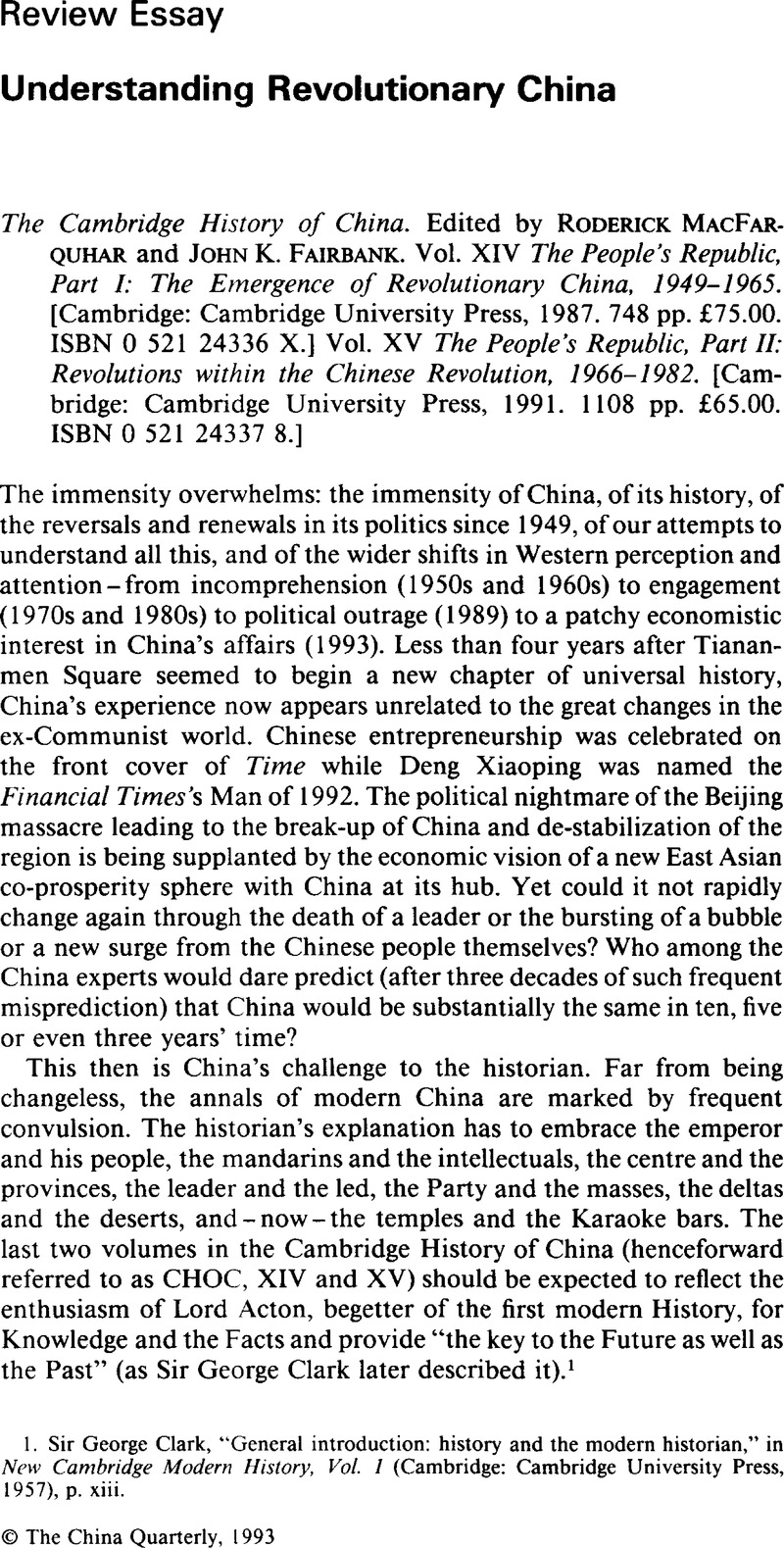Article contents
Understanding Revolutionary China
Published online by Cambridge University Press: 12 February 2009
Abstract

- Type
- Review Essay
- Information
- Copyright
- Copyright © The China Quarterly 1993
References
1. SirClark, George, “General introduction: history and the modern historian,” in New Cambridge Modern History, Vol. I (Cambridge: Cambridge University Press, 1957), p. xiiiGoogle Scholar.
2. Binyan, Liu, A Higher Kind of Loyalty (London: Methuen, 1990), p. 99Google Scholar.
3. Gray, Jack, Rebellions and Revolutions: China from the 1800s to the 1980s (Oxford: Oxford University Press, 1990), pp. 309–310Google Scholar.
4. Great Leap song from Henan, Dengfeng, Songs of the Red Flag (Beijing: Foreign Languages Press, 1961), p. 39Google Scholar.
5. MacFarquhar, Roderick, Origins of the Cultural Revolution, Vol. 2: The Great Leap Forward, 1958–60 (New York: Cambridge University Press, 1983)Google Scholar; David Bachman, , Bureaucracy, Economy, and Leadership in China: The Institutional Origins of the Great Leap Forward (Cambridge: Cambridge University Press, 1991)CrossRefGoogle Scholar; Strong, Anna Louise, The Rise of the Chinese People's Communes (Beijing: New World Press, 1959)Google Scholar.
6. Hinton, William, “The Chinese Revolution: was it necessary? Was it successful? Is it still going on?” Monthly Review, Vol. 43, No. 6 (11 1991), pp. 7–8CrossRefGoogle Scholar.
7. Ruoshui, Wang, “Comment” in BCAS Bulletin, Vol. 24, No. 1 (1992)Google Scholar.
8. Karol, K.S., The Second Chinese Revolution (London: Jonathan Cape, 1975), p. 5Google Scholar.
9. Chunqiao, Zhang, “On exercising all-round dictatorship against the bourgeoisie,” Honggi (Red Flag), No. 4 (1975)Google Scholar.
10. Binyan, Liu, A Higher Kind of Loyalty, p. 114Google Scholar.
11. Gittings, John, China Changes Face (Oxford: Oxford University Press 1990), ch. 5Google Scholar.
12. Shaozhi, Su, Democratization and Reform (Nottingham: Spokesman Books, 1988)Google Scholar; Goldman, Merle “Hu Yaobang's intellecutual network and the theory conference of 1979”, The China Quarterly, No. 126 (06 1991), pp. 219–242Google Scholar.
13. I have discussed Mao's, distinctive world view in The World and China, 1922–1972 (London: Eyre–Methuen, 1974), pp. 142–48Google Scholar. See Mao's interviews with Strong, Anna Louise in Amerasia, 04 and 06 1947Google Scholar.
14. Mao, quoted in Gittings, The World and China, p. 229Google Scholar. In a recent article on the causes of China's “‘leftist’ mistakes,” Qiaomu, Hu cites as one reason “‘the deterioration of the international environment from 1950 to 1970 and [China's] over-reaction.“ Xuexi (Study), No. 1 (1992)Google Scholar.
15. Shue, Vivienne, The Reach of the State (Stanford: Stanford University Press, 1988)Google Scholar; special issue on “The Individual and the State in China,” The China Quarterly, No. 127 (09 1991)Google Scholar.
16. The first but certainly not the last example of this approach is Salisbury, Harrison E., The New Emperors: Mao and Deng, a Dual Biography (London: HarperCollins, 1992)Google Scholar.
- 1
- Cited by




